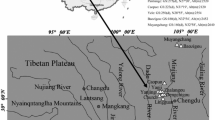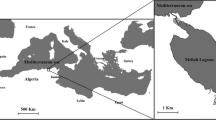Abstract
To elucidate the life history of neustonic animals, growth and reproductive patterns were investigated in the hermaphroditic pedunculate barnacle Lepas anserifera in field and laboratory experiments in Wakayama, western Japan from 2006 to 2008. The effects of temperature (19, 24 or 29°C) and food availability (once or twice a week) on growth and reproduction were also studied in the laboratory. The barnacles grew and matured rapidly, especially in the field: individuals on the average grew from 3 mm to more than 12 mm in capitulum length within 15 days and some were brooding. High temperature and high food availability resulted in greater growth. High temperature also resulted in earlier maturation of both testes and ovaries, whereas the effect of food availability was less clear. The rapid growth and maturation, together with earlier maturation at higher temperatures, may be an adaptation to ephemeral floating objects to which they attach.


Similar content being viewed by others
References
Angeloni L, Bradbury JW, Charnov EL (2002) Body size and sex allocation in simultaneously hermaphroditic animals. Behav Ecol 13:419–426
Anton JF (1949) Stalked barnacles on the shores of the British Isles. Scottish Natur 61:65–67
Bauer RT (2006) Same sexual system but variable sociobiology: evolution of protandric simultaneous hermaphroditism in Lysmata shrimps. Integr Comp Biol 46:430–438
Bieri R (1966) Feeding preferences and rates of the snail, Ianthina prolongata, the barnacle, Lepas anserifera, the nudibranchs, Glaucus atlanticus and Fiona pinnata, and the food web in the marine neuston. Publ Seto Mar Biol Lab 14:161–170
Charnov EL (1987) Sexuality and hermaphroditism in barnacles: a natural selection approach. In: Southward AJ (ed) Barnacle biology. AA Balkema, Rotterdam, Netherlands, pp 89–103
Crisp DJ (1983) Chelonobia patula (Ranzani), a pointer to the evolution of the complemental male. Mar Biol Lett 4:281–294
Darwin C (1851) A monograph on the sub-class Cirripedia, I. The Lepadidae. Ray Society, London
Emmerson WD (1980) Ingestion, growth and development of Penaeus indicus larvae as a function of Thalassiosira weissflogii cell concentration. Mar Biol 58:65–73. doi:10.1007/BF00386881
Evans F (1958) Growth and maturity of the barnacles Lepas hillii and Lepas anatifera. Nature 182:1245–1246
Green A, Tyler PA, Angel MV, Gage JD (1994) Gametogenesis in deep- and surface-dwelling oceanic stalked barnacles from the NE Atlantic Ocean. J Exp Mar Biol Ecol 184:143–158
Hoek PPC (1907) The cirripedia of the Siboga Expedition A. Cirripedia Pedunculata. Siboga-Expeditie 31a:1–128
Jeffries WB, Voris HK, Yang CM (1985) Growth of Octolasmis cor (Aurivillius, 1892) on the gills of Scylla serrata (Forskal, 1755). Biol Bull 169:291–296
Jones EC (1967) Lepas anserifera Linne (Cirripedia Lepadomorpha) feeding on fish and Physalia. Crustaceana 14:311–313
Kaufmann R (1965) Zur embryonal- und larvalentwicklung von Scalpellum scalpellum L. (Crust. Cirr.). Z Morph Ökol Tiere 55:161–232
Lewis CA, Chia F-S (1981) Growth, fecundity, and reproductive biology in the pedunculate cirripede Pollicipes polymerus at San Juan Island, Washington. Can J Zool 59:893–901
MacIntyre RJ (1966) Rapid growth in stalked barnacle. Nature 212:637–638
National Astronomical Observatory of Japan (2007) Chronological scientific table, Tokyo, Japan (in Japanese)
Newman WA (1971) Lepadids from the Caroline Islands (Cirripedia Thoracica). Crustaceana 22:31–38
Ozaki Y, Yusa Y, Yamato S, Imaoka T (2008) Reproductive ecology of the pedunculate barnacle Scalpellum stearnsii (Cirripedia: Lepadomorpha: Scalpellidae). J Mar Biol Assoc UK 88:77–83. doi:10.1017/S0025315408000131
Patel B (1959) The influence of temperature on the reproduction and moulting of Lepas anatifera L. under laboratory conditions. J Mar Biol Assoc UK 38:589–597
Poleck TP, Denys CJ (1982) Effect of temperature on the molting, growth and maturation of the antarctic krill Euphausia superba (Crustacea: Euphausiacea) under laboratory conditions. Mar Biol 70:255–265. doi:10.1007/BF00396844
Skerman TM (1958) Rate of growth in two species of Lepas (Cirripedia). N Z J Sci 1:402–411
Stearns SC, Koella JC (1986) The evolution of phenotypic plasticity in life-history traits: predictions of reaction norms for age and size at maturity. Evolution 40:893–913
Suprayudi MA, Takeuchi T, Hamasaki K, Hirokawa J (2002) Effect of Artemia feeding schedule and density on the survival and development of larval mud crab Scylla serrata. Fisheries Sci 68:1295–1303. doi:10.1046/j.1444-2906.2002.00567.x
Thiel M, Gutow L (2004) The ecology of rafting in the marine environment. I. The floating substrata. Ocean Mar Biol Annu Rev 42:181–264. doi::10013/epic.20198.d001
Thiel M, Gutow L (2005) The ecology of rafting in the marine environment. II. The rafting organisms and community. Ocean Mar Biol Annu Rev 43:279–418. doi:10013/epic.22063.d001
Tsikhon-Lukanina EA, Reznichenko OG, Nikolaeva GG (2001) Ecology of invertebrates on the oceanic floating substrata in the northwest Pacific Ocean. Oceanology 41:550–555
Yamaguchi S, Yusa Y, Yamato S, Urano S, Takahashi S (2008) Mating group size and evolutionarily stable pattern of sexuality in barnacles. J Theor Biol 253:61–73. doi:10.1016/j.jtbi.2008.01.025
Yan Y, Chan BKK, Williams A (2006) Reproductive development of the barnacle Chthamalus malayensis in Hong Kong: implications for the life-history patterns of barnacles on seasonal, tropical shores. Mar Biol 148:875–887. doi:10.1007/s00227-005-0117
Yusa Y, Abe N (1996) Rapid growth of a stalked barnacle, Lepas anserifera Linnaeus settled on a miniature ship. The Nanki seibutu 38:1–3 (in Japanese)
Acknowledgments
We thank K. Wada, H. Sato, the editor and reviewers for their valuable comments, Y. Yamamoto, K. Okita, S. Urano, Y. Kitano, M. Matsumura and S. Serizawa for technical advice and help. The authors declare that they have no conflict of interest.
Author information
Authors and Affiliations
Corresponding author
Additional information
Communicated by J. P. Grassle.
Rights and permissions
About this article
Cite this article
Inatsuchi, A., Yamato, S. & Yusa, Y. Effects of temperature and food availability on growth and reproduction in the neustonic pedunculate barnacle Lepas anserifera . Mar Biol 157, 899–905 (2010). https://doi.org/10.1007/s00227-009-1373-0
Received:
Accepted:
Published:
Issue Date:
DOI: https://doi.org/10.1007/s00227-009-1373-0




